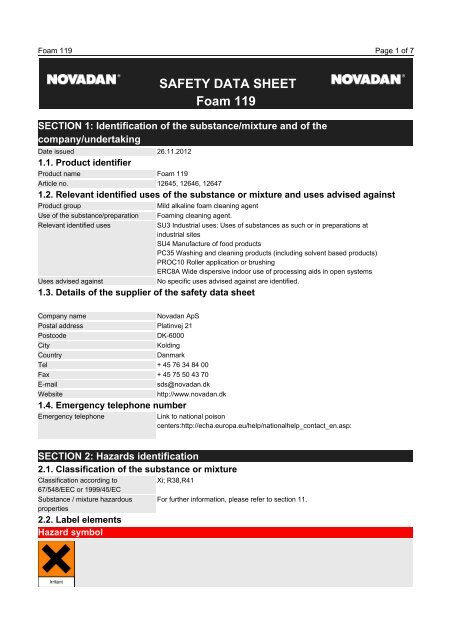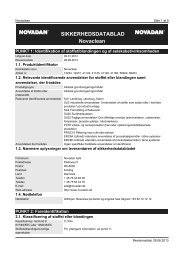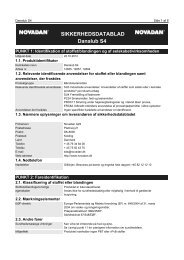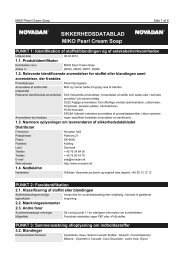SAFETY DATA SHEET Foam 119 - Creuna
SAFETY DATA SHEET Foam 119 - Creuna
SAFETY DATA SHEET Foam 119 - Creuna
You also want an ePaper? Increase the reach of your titles
YUMPU automatically turns print PDFs into web optimized ePapers that Google loves.
<strong>Foam</strong> <strong>119</strong> Page 1 of 7<br />
<strong>SAFETY</strong> <strong>DATA</strong> <strong>SHEET</strong><br />
<strong>Foam</strong> <strong>119</strong><br />
SECTION 1: Identification of the substance/mixture and of the<br />
company/undertaking<br />
Date issued 26.11.2012<br />
1.1. Product identifier<br />
Product name <strong>Foam</strong> <strong>119</strong><br />
Article no. 12645, 12646, 12647<br />
1.2. Relevant identified uses of the substance or mixture and uses advised against<br />
Product group Mild alkaline foam cleaning agent<br />
Use of the substance/preparation <strong>Foam</strong>ing cleaning agent.<br />
Relevant identified uses SU3 Industrial uses: Uses of substances as such or in preparations at<br />
industrial sites<br />
SU4 Manufacture of food products<br />
PC35 Washing and cleaning products (including solvent based products)<br />
PROC10 Roller application or brushing<br />
ERC8A Wide dispersive indoor use of processing aids in open systems<br />
Uses advised against No specific uses advised against are identified.<br />
1.3. Details of the supplier of the safety data sheet<br />
Company name Novadan ApS<br />
Postal address Platinvej 21<br />
Postcode DK-6000<br />
City Kolding<br />
Country Danmark<br />
Tel + 45 76 34 84 00<br />
Fax + 45 75 50 43 70<br />
E-mail sds@novadan.dk<br />
Website http://www.novadan.dk<br />
1.4. Emergency telephone number<br />
Emergency telephone Link to national poison<br />
centers:http://echa.europa.eu/help/nationalhelp_contact_en.asp:<br />
SECTION 2: Hazards identification<br />
2.1. Classification of the substance or mixture<br />
Classification according to<br />
67/548/EEC or 1999/45/EC<br />
Substance / mixture hazardous<br />
properties<br />
2.2. Label elements<br />
Hazard symbol<br />
Xi; R38,R41<br />
For further information, please refer to section 11.
<strong>Foam</strong> <strong>119</strong> Page 2 of 7<br />
R phrases R38 Irritating to skin.<br />
R41 Risk of serious damage to eyes.<br />
S phrases S26 In case of contact with eyes, rinse immediately with plenty of water and<br />
seek medical advice.<br />
S39 Wear eye/face protection.<br />
EEC-directive Regulation (EC) No 648/2004 of the European Parliament and of the Council<br />
of 31 March 2004 on detergents.<br />
Dangerous Preparations Directive 1999/45/EC.<br />
Dangerous Substance Directive 67/548/EEC.<br />
2.3. Other hazards<br />
Health effect May cause permanent damage to the eyes, especially if the product is not<br />
washed away IMMEDIATELY. See section 11 for additional information on<br />
health hazards.<br />
Environmental effect The product contains a substance which is hazardous to aquatic organisms.<br />
See section 12 as well. Substantial amounts of the product may lead to a<br />
local change in acidity in small water systems which may have adverse<br />
effects on aquatic organisms.<br />
This product does not contain any PBT or vPvB substances.<br />
SECTION 3: Composition/information on ingredients<br />
3.2. Mixtures<br />
Component name Identification Classification Contents<br />
Disodium metasilicate, pentahydrate CAS no.: 10213-79-3<br />
EC no.: 229-912-9<br />
C, Xi; R34, R37 1 - 5 %<br />
Sodium carbonate CAS no.: 497-19-8<br />
EC no.: 207-838-8<br />
Index no.: 011-005-00-2<br />
Xi; R36<br />
Eye Irrit. 2; H319<br />
1 - 5 %<br />
Fattyalkoholethoxylate CAS no.: 68439-46-3 Xi; R38,R41 1 - 5 %<br />
Hexyl-D-Glucoside CAS no.: 54549-24-5<br />
Xi; R41<br />
1 - 5 %<br />
Registration number: 01-<br />
2<strong>119</strong>492545-29<br />
Eye Dam. 1; H318;<br />
Fatty acids, C8-10 CAS no.: 68937-75-7<br />
EC no.: 273-086-2<br />
Registration number: 01-<br />
2<strong>119</strong>555294-36<br />
C; R34 1 - 5 %<br />
Dipropyleneglycolmonomethylether CAS no.: 34590-94-8<br />
EC no.: 252-104-2<br />
1 - 5 %<br />
Amines, C10-16-alkyldimethyl, N- CAS no.: 70592-80-2<br />
Xi,N; R38,R41,R50 < 1 %<br />
oxides<br />
EC no.: 274-687-2<br />
Component comments 5-15%: nonionic surfactant ,<br />
<strong>Foam</strong> <strong>119</strong> Page 3 of 7<br />
Ingestion Rinse mouth thoroughly with water and give large amounts of milk or water<br />
to people not unconscious. Get medical attention if any discomfort continues.<br />
Recommended personal protective Wear necessary protective equipment. For personal protection, see section 8.<br />
equipment for first aid responders<br />
4.2. Most important symptoms and effects, both acute and delayed<br />
Acute symptoms and effects As described in section 2.2 and 2.3.<br />
Delayed symptoms and effects No known long term effects.<br />
4.3. Indication of any immediate medical attention and special treatment needed<br />
Other Information If unconscious: Call an ambulance/physician immediately. Show this Safety<br />
Data Sheet.<br />
SECTION 5: Firefighting measures<br />
5.1. Extinguishing media<br />
Suitable extinguishing media Use fire-extinguishing media appropriate for surrounding materials.<br />
5.2. Special hazards arising from the substance or mixture<br />
Fire and explosion hazards This product is not flammable. During fire, gases hazardous to health may be<br />
formed. Water used for fire extinguishing, which has been in contact with the<br />
product, may be corrosive.<br />
5.3. Advice for firefighters<br />
Personal protective equipment Wear necessary protective equipment. For personal protection, see section 8.<br />
Fire fighting procedures Reference is made to the company fire procedure. If risk of water pollution<br />
occurs, notify appropriate authorities. Avoid breathing fire vapours.<br />
SECTION 6: Accidental release measures<br />
6.1. Personal precautions, protective equipment and emergency procedures<br />
Personal precautions Wear necessary protective equipment. For personal protection, see section 8.<br />
6.2. Environmental precautions<br />
Environmental precautions Avoid discharge into water courses or onto the ground. Contact local<br />
authorities in case of spillage to drain/aquatic environment.<br />
6.3. Methods and material for containment and cleaning up<br />
Methods for cleaning Dam and absorb spillage with sand, sawdust or other absorbent. Wash<br />
contaminated area with water.<br />
6.4. Reference to other sections<br />
Other instructions See section 8 and section 13.<br />
SECTION 7: Handling and storage<br />
7.1. Precautions for safe handling<br />
Handling Avoid spilling, skin and eye contact. Use work methods which minimise<br />
spreading of vapours, dust, smoke, aerosols, splashes etc. to the extent<br />
technically possible.<br />
7.2. Conditions for safe storage, including any incompatibilities<br />
Storage Store in tightly closed original container. Keep away from food, drink and<br />
animal feeding stuffs. Store protected from acids. Store above freezing.<br />
Storage Temperature Value: 0-35 °C<br />
Storage Stabilit Durability: 36 months.<br />
7.3. Specific end use(s)<br />
Specific use(s) The identified uses for this product are detailed in Section 1.2.<br />
SECTION 8: Exposure controls/personal protection<br />
8.1. Control parameters
<strong>Foam</strong> <strong>119</strong> Page 4 of 7<br />
Exposure limit values<br />
Component name Identification Value Year<br />
Dipropyleneglycolmonomethylether CAS no.: 34590-94-8<br />
EC no.: 252-104-2<br />
8 h.: 308 mg/m3<br />
8 h.: 50 ppm<br />
DNEL / PNEC<br />
Summary of risk management Data lacking.<br />
measures, man<br />
Summary of risk management Data lacking.<br />
measures, environment<br />
8.2. Exposure controls<br />
Recommended monitoring<br />
Not available.<br />
procedures<br />
Occupational exposure controls Personal protection equipment should be chosen according to the CEN<br />
standards and in discussion with the supplier of the personal protective<br />
equipment. An eye wash bottle must be available at the work site.<br />
Safety signs<br />
Respiratory protection<br />
Respiratory protection In case of inadequate ventilation use suitable respirator. Use respiratory<br />
equipment with combination filter, type A2/P2.<br />
Hand protection<br />
Hand protection Protective gloves must be used if there is a risk of direct contact or splash.<br />
Use protective gloves made of: Butyl rubber. Nitrile. Neoprene.<br />
Eye / face protection<br />
Eye protection Use eye protection.<br />
Skin protection<br />
Skin protection (other than of the No special precautions.<br />
hands)<br />
Thermal hazards<br />
Thermal hazards See section 5.<br />
Appropriate environmental exposure control<br />
Environmental exposure controls See section 6.<br />
SECTION 9: Physical and chemical properties<br />
9.1. Information on basic physical and chemical properties<br />
Physical state Fluid.<br />
Colour Yellow.<br />
Odour No characteristic odour.<br />
pH (as supplied) Value: ~ 11,5<br />
pH (aqueous solution) Value: ~ 10,5<br />
Comments, pH (aqueous solution) 1%<br />
Solubility description Completely soluble in water.<br />
Viscosity Value: < 50 mPas.<br />
9.2. Other information<br />
Bulk density Value: ~ 1,10 kg/l<br />
Other physical and chemical properties<br />
Comments No data recorded.<br />
2005
<strong>Foam</strong> <strong>119</strong> Page 5 of 7<br />
SECTION 10: Stability and reactivity<br />
10.1. Reactivity<br />
Reactivity There are no known reactivity hazards associated with this product.<br />
10.2. Chemical stability<br />
Stability Stable under normal temperature conditions and recommended use.<br />
10.3. Possibility of hazardous reactions<br />
Possibility of hazardous reactions Reacts violently with strong acids.<br />
Risk of bumping (splashes).<br />
10.4. Conditions to avoid<br />
Conditions to avoid Heating.<br />
Extremes of temperatures.<br />
Avoid contact with acids.<br />
Avoid frost.<br />
10.5. Incompatible materials<br />
Materials to avoid Strong acids.<br />
Acids, oxidising.<br />
Alkali-sensitive metals such as aluminium, tin, lead and zinc and alloys with<br />
these metals.<br />
10.6. Hazardous decomposition products<br />
Hazardous decomposition products In case of fire, toxic gases (CO, CO2, NOx) may be formed.<br />
SECTION 11: Toxicological information<br />
11.1. Information on toxicological effects<br />
Toxicological Information:<br />
Other toxicological data Toxicological tests on the product has not been performed.<br />
Components' toxicological data<br />
Component No data available for ingredient(s).<br />
LD50 oral Value: - -<br />
Test animal species: -<br />
Duration: -<br />
Comments: -<br />
Other information regarding health hazards<br />
General This chemical may cause skin/eye irritation.<br />
Potential acute effects<br />
Inhalation Aerosols irritate the respiratory system, and may cause coughing and<br />
difficulties in breathing.<br />
Skin contact Irritating to skin. Prolonged or frequent contact may cause redness, itching,<br />
eczema and skin cracking.<br />
Eye contact Strongly corrosive. Causes severe burns and serious eye damage. Immediate<br />
first aid is imperative. Contact with concentrated chemical may very rapidly<br />
cause severe eye damage, possibly loss of sight.<br />
Ingestion Ingestion may cause irritation of the gastrointestinal tract, vomiting and<br />
diarrhoea.<br />
Symptoms of Exposure<br />
Symptoms of overexposure No specific symptoms noted.<br />
SECTION 12: Ecological information<br />
12.1. Toxicity<br />
Ecotoxicity The product contains a substance which is very toxic to aquatic organisms.<br />
Large amounts of the product may affect the acidity (pH-factor) in water with
<strong>Foam</strong> <strong>119</strong> Page 6 of 7<br />
possible risk of harmful effects to aquatic organisms.<br />
Aquatic, comments No data recorded.<br />
Components' toxicological data<br />
Component No data available for ingredient(s).<br />
Aquatic, comments -<br />
12.2. Persistence and degradability<br />
Chemical oxygen demand (COD) Value: < 500 mg O2/g<br />
Persistence and degradability The product is expected to be biodegradable.<br />
12.3. Bioaccumulative potential<br />
Bioaccumulative potential The product does not contain any substances expected to be bioaccumulating.<br />
12.4. Mobility in soil<br />
Mobility Not regarded as dangerous for the environment. The product is water soluble<br />
and may spread in water systems.<br />
12.5. Results of PBT and vPvB assessment<br />
PBT assessment results Not Classified as PBT/vPvB by current EU criteria.<br />
12.6. Other adverse effects<br />
Environmental details, conclusion For this product no classification is required for environmental hazards.<br />
SECTION 13: Disposal considerations<br />
13.1. Waste treatment methods<br />
Specify the appropriate methods of<br />
disposal<br />
Product classified as hazardous<br />
waste<br />
Packaging classified as hazardous<br />
waste<br />
Do not empty into drains; dispose of this material and its container at<br />
hazardous or special waste collection point. Dispose of waste and residues in<br />
accordance with local authority requirements.<br />
Yes<br />
Yes<br />
EWC waste code EWC: 0706 wastes from the MFSU of fats, grease, soaps, detergents,<br />
disinfectants and cosmetics<br />
Other Information When handling waste, consideration should be made to the safety precautions<br />
applying to handling of the product. Waste code applies to product remnants<br />
in pure form.<br />
SECTION 14: Transport information<br />
14.1. UN number<br />
Comment The product is not covered by international regulation on the transport of<br />
dangerous goods (IMDG, IATA, ADR/RID).<br />
14.2. UN proper shipping name<br />
Comment Not relevant.<br />
14.3. Transport hazard class(es)<br />
Comment Not relevant.<br />
14.4. Packing group<br />
Comment Not relevant.<br />
14.5. Environmental hazards<br />
Comment Not relevant.<br />
14.6. Special precautions for user<br />
Special precautions for user Not applicable.<br />
14.7. Transport in bulk according to Annex II of MARPOL 73/78 and the IBC Code<br />
Other applicable information.<br />
Other applicable information. Not relevant.
<strong>Foam</strong> <strong>119</strong> Page 7 of 7<br />
SECTION 15: Regulatory information<br />
15.1. Safety, health and environmental regulations/legislation specific for the<br />
substance or mixture<br />
Other Label Information For professional users only.<br />
As a general rule, persons under 18 years of age are not allowed to work<br />
with this product. Users must be carefully instructed in the proper work<br />
procedure, the dangerous properties of the product and the necessary safety<br />
instructions.<br />
Legislation and regulations The Management of Health and Safety at Work Regulations 1999 (SI 1999<br />
No. 3242).<br />
Regulation (EC) No 1907/2006 of the European Parliament and of the Council<br />
of 18 December 2006 concerning the Registration, Evaluation, Authorisation<br />
and Restriction of Chemicals (REACH), establishing a European Chemicals<br />
Agency, amending Directive 1999/45/EC and repealing Council Regulation<br />
(EEC) No 793/93 and Commission Regulation (EC) No 1488/94 as well as<br />
Council Directive 76/769/EEC and Commission Directives 91/155/EEC,<br />
93/67/EEC, 93/105/EC and 2000/21/EC, including amendments.<br />
The List of Wastes (England) (Amendment) Regulations 2005. (SI 2005 No.<br />
895).<br />
EH40/2005, Workplace exposure limits 2005, with amendments.<br />
15.2. Chemical safety assessment<br />
Chemical safety assessment has<br />
been carried out<br />
No<br />
SECTION 16: Other information<br />
List of relevant R phrases (under<br />
headings 2 and 3).<br />
List of relevant H-phrases (Section<br />
2 and 3).<br />
R34 Causes burns.<br />
R36 Irritating to eyes.<br />
R37 Irritating to respiratory system.<br />
R38 Irritating to skin.<br />
R41 Risk of serious damage to eyes.<br />
R50 Very toxic to aquatic organisms.<br />
H318 Causes Serious eye damage.<br />
H319 Causes Serious eye irritation.<br />
Training advice No particular training or education is required but the user must be familiar<br />
with this SDS. Users must be carefully instructed in the proper work<br />
procedure, the dangerous properties of the product and the necessary safety<br />
instructions.<br />
Information which has been added, All sections of the safety data sheet is updated.<br />
deleted or revised<br />
Responsible for safety data sheet Novadan ApS<br />
Prepared by TLT






